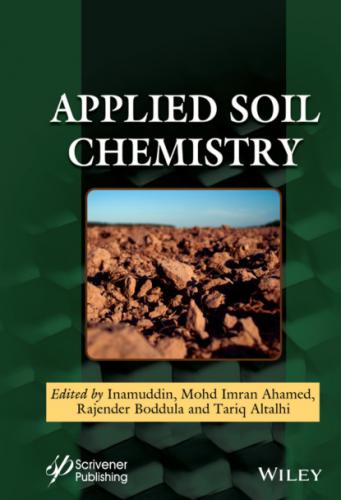Chapter 3 discusses the effect that agricultural management systems have on soil health by evaluating reduced processing systems, organic fertilizers, and biological control of weeds, along with their effect on the bioeconomy, including agriculture, forestry, fishing, aquaculture, woodworking, biorefineries, and nanobiotechnology. The data provided is based on the evaluation of indicators of physical, chemical, biological, microbiological, and biochemical soil health. The benefits of soil resilience and better adaptation to extreme events are also included.
Chapter 4 discusses the advances in soil chemistry which are based on the analysis of the soil at an in-situ level and the presence of carbon speciation in soil. The analysis of the soil using sensors, the internet of things, machine learning, artificial intelligence, and drones with big data are also discussed.
Chapter 5 details the various components of soil, including solid, liquid and gaseous phases. Different soil characteristics like structure, soil color, texture, bulk density and particle size are discussed in detail. These are important parameters for understanding soil behavior. Sorption behavior of soil for removal of heavy metals is also discussed.
Chapter 6 relates to inclusive edaphology and environmental reactions. Parameters such as composition, textures, soil organic matter, salinity, acidity and chemical reaction of soil are discussed. The main focus is on different kinds of contaminants like pesticides, modern agriculture, synthetic chemicals and their effects on plant growth.
Chapter 7 describes fertilization and fertilizer types. The purpose of fertilization and its application methods are discussed. Fertilizers can be classified into two types depending on the source from which they are obtained: organic (natural) fertilizer and chemical fertilizer. The importance of the use of fertilizers in agricultural lands for sustainable agriculture is explained.
Chapter 8 discusses several approaches which are used to control the overabundance of heavy metals present in soil. The focus of this chapter are the techniques utilized in the past few years to estimate heavy metal content and its mitigation process.
Chapter 9 details the importance and benefits of modeling studies about the retention and mobilization of pollutants. Recently applied models and primary outcomes of modeling studies are also discussed. Additionally, several personal computer programs, which are used for running models, are exemplified in this study.
Chapter 10 provides details of the different laws of soil chemistry. The reaction of ions with the variable charged mineral surfaces, organic matters and clay minerals are discussed. The role of water movement through saturated and unsaturated media is also discussed, with a major focus on gravitational and capillary forces.
Chapter 11 discusses various aspects of assessing the quality of soil using mechanical and physicochemical parameters. Mechanical parameters, which play an essential role in plant growth, are also discussed. There is also a discussion of ion-exchange properties, which is the primary focus of the studies on physicochemical parameters.
Chapter 12 explains the necessary soil functions that could lead to an increase in agricultural production. Essential soil biological processes and their relationship with soil pH are also discussed along with microbial ecophysiological indicators and activities of soil enzymes.
Chapter 13 provides detailed information on the application of pesticides in agriculture. It also elaborates on the numerous types of pesticides, including neonicotinoids, pyrethroids, organochlorines, organophosphates, triazines, carbamates, and pyrethroids. The merits and demerits that are associated with chemical pesticides are also highlighted. This chapter also includes the modes of action and the detrimental effects of these pesticides.
Inamuddin, Mohd Imran Ahamed, Rajender Boddula and Tariq Altalhi February 15, 2021
1
Potential and Challenges of Carbon Sequestration in Soils
Erfan Sadatshojaei1*, David A. Wood2 and Mohammad Reza Rahimpour3
1Department of Chemical Engineering, Shiraz University, Shiraz, Iran
2DWA Energy Limited, Bassingham, Lincoln, United Kingdom
3Department of Chemical Engineering, Shiraz University, Shiraz, Iran
Abstract
Terrestrial soils, by volume, represent the most significant land-based carbon store on our planet. Over time, soils absorb carbon from a wide range of organisms as they respire during life and decompose after their demise. Carbon currently residing in the upper soil layers constitutes more than the combined quantity of carbon in land-surface vegetation and the atmosphere. Retaining and ideally boosting that carbon store in soils and preventing that carbon entering the atmosphere is of paramount importance in the fight against climate change. Almost 50% of global soils within about 1 m of the surface have been disturbed by agriculture releasing at least some of the carbon they store to the atmosphere. Carbon ideally needs to become mineralized in soils if it is to be stabilized and sequestered in the subsurface over the long term. Unfortunately, a significant portion of carbon in soils has a relative rapid turnover time, or low residence time, and is returned to the atmosphere as carbon dioxide via soil respiration processes. Whereas, it takes much longer for some of the soil carbon to be converted to stable mineralized forms. Soil erosion, as well as tillage, plays a significant role in releasing some soil carbon to the atmosphere. Converting significant areas of croplands and grazing lands to forests, grassland, and wetlands is the best option currently available for increasing the soils uptake of carbon from the atmosphere. Additionally, plant large quantities of perennial deep-rooted, fast growing bioenergy crops, such as switchgrass and miscanthus, can increment the carbon storage potential of grassland soils. The aggressive implementation of such actions has the potential to increase global soil carbon storage by between 0.5 and 2.0 Pg C a−1 for several decades. This could only be achieved in association with large-scale reforestation and robust steps to mitigate anthropogenic soil disturbance and natural erosion.
Keywords: Soil as a carbon store, carbon turnover time, climate change mitigation, soil disturbance, organic matter decomposition, humification and peat formation, carbon mineralization, soil C sequestration potential
List of Abbreviations and Units
1 petagram (Pg) = 1015 grams = 1 gigatonne
1 kilogram (kg) of carbon is equivalent to 44/12 of carbon dioxide
1 hectare (ha) = 107,639 square feet = 10,000 square meters
1 acre = 43,560 square feet = 4047 square meter
